One of the outer islands of Vanuatu is Tanna, located about 40 minutes flying time south east of Port Vila.

Map of Tanna at White Grass Airport.
Peter and Kerry stayed at White Grass Ocean Resort on Tanna’s west coast for two nights in October 2016. The location has a superb outlook and is just 2km from the airport. Although the bure we stayed in was compact, it was quite comfortable for two and it had a lovely patio with chairs and a small table. The resort dining area provides a full breakfast as part of the tariff and great meals for lunch and dinner.
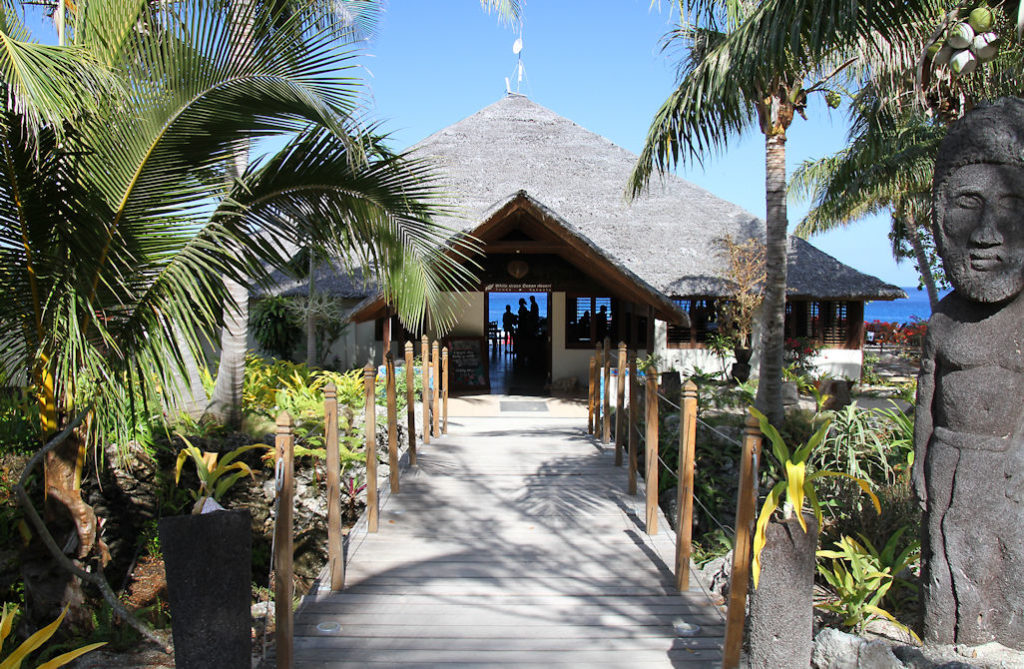
Reception and dining area at White Grass Ocean Resort.
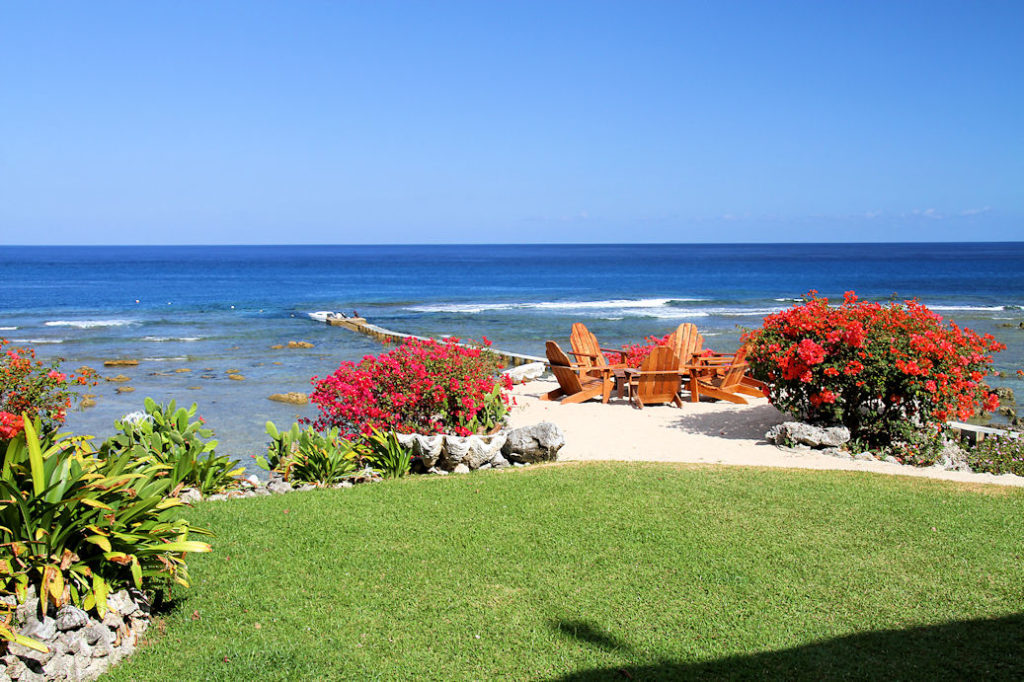
Looking out the dining area windows to the west. The resort has beautiful flowers throughout.
The first known European to visit Tanna was James Cook in August 1774 while on his second Pacific voyage of exploration. He was attracted to the island by the smoke and night time glow from the active volcano Mt Yasur and anchored in a bay nearby that is still known as Port Resolution, after Cook’s ship.
Mt Yasur is the reason that most tourists now visit Tanna as it is probably the most accessible active volcano in the world. It is possible to climb onto the rim of the crater, just a couple of hundred metres from the vents that spew ash, smoke and fiery lava into the air.
The resort arranged a tour to Mt Yasur for several of the guests. Four of us plus the driver left White Grass in the resort’s 4WD at about 2:40pm, bouncing across the middle of the island, through the area known as Middlebush. It is a bit less than an hour and a half to the mountain but the roads are unsealed and are quite rough in some places. On the way we drove through several small villages, most of which had houses with thatched roofs and walls.
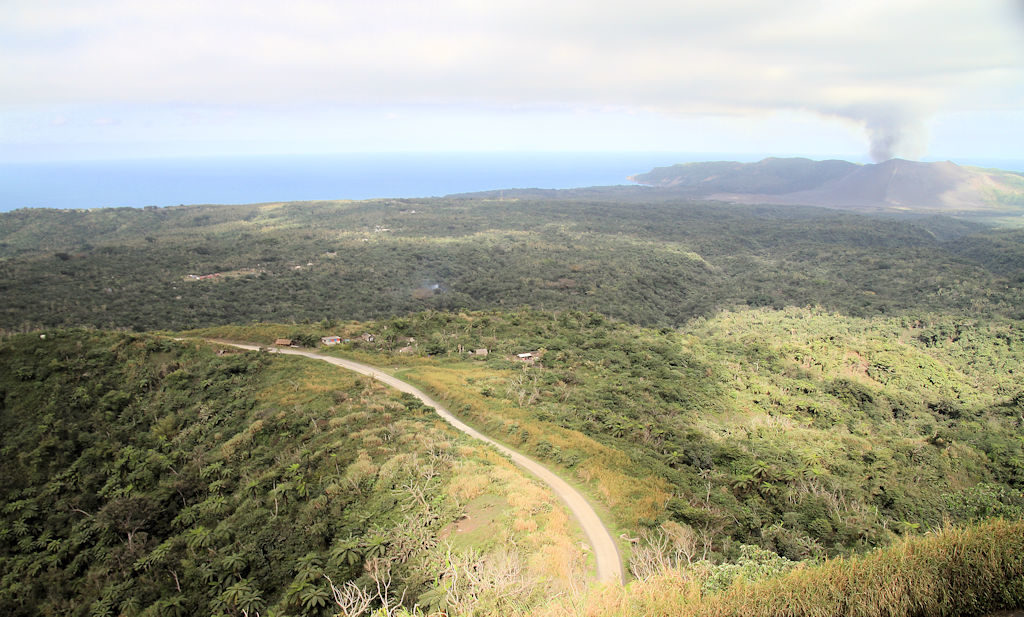
The first view of Mt Yasur.
We stopped a couple of times along the way – the first time when Mt Yasur initially came into view and the second time on the ash plain below the mountain to get an impression of how desolate that area is. As soon as the mountain was in sight the deep rumblings could be heard – a bit like distant thunder. The ash plain was quite a surprise, too, as it is quite firm and easily supported the weight of quite large vehicles.
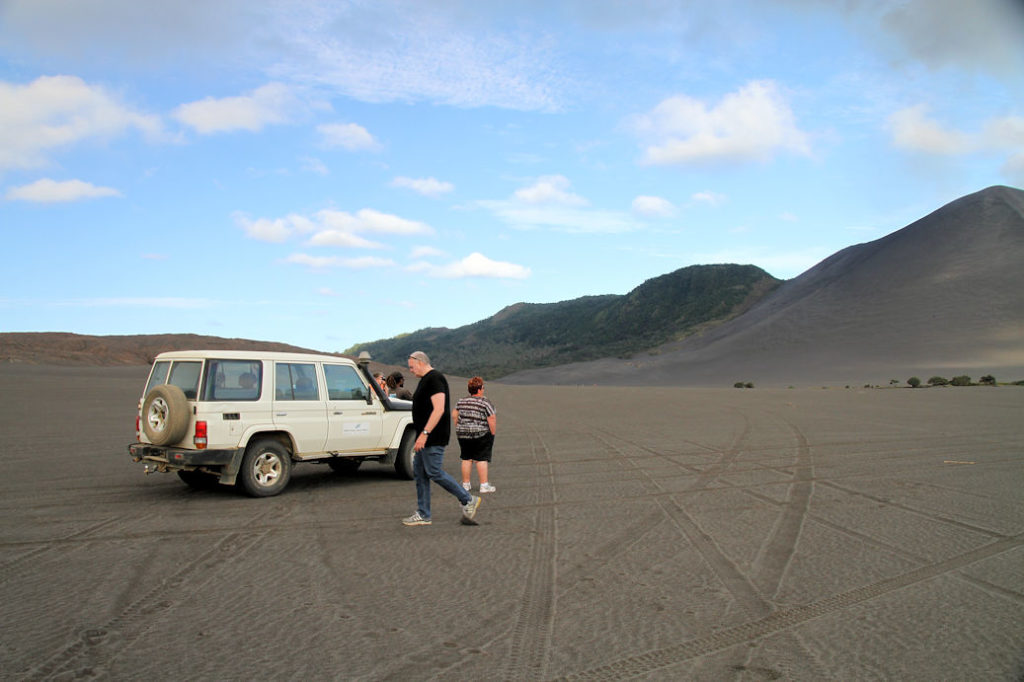
On the ash plain, with the cone to the right.
After crossing the ash plain we drove up to the volcano reception centre, managed by local guides. There were about fifty tourists spread among a number of different tour groups and we were divided into our diverse nationalities. Local villagers put on a traditional dance before we watched the local chief carry out the ceremony of asking the volcano spirit if we could visit safely.
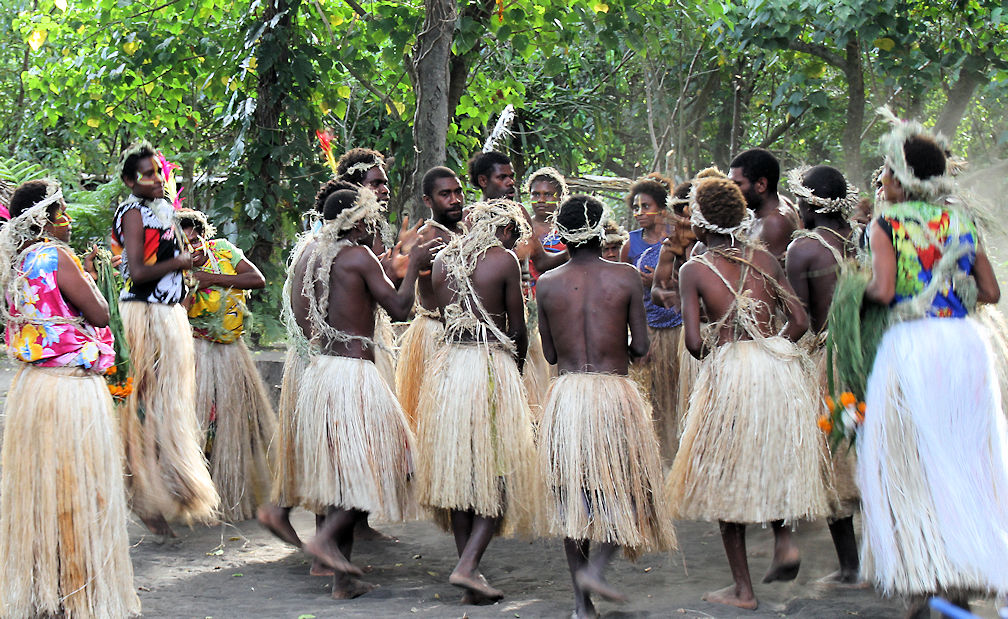
Local dancers.
Once ‘approval’ was received we were allocated to different dual-cab utilities to be transported to the parking area below the summit. Mostly the older people were put inside the vehicles, while young ones and those with children were seated on benches in the rear trays. It was an extremely rough climb up the mountain, so I pity those hanging on in the back!
From the car park the group was directed up a concrete path to another holding area near the crater. This path was quite steep at the beginning but should be manageable by most people. It has no handrails, but wooden posts are set in the ground every 5 or 10 metres. A guide leads the way up and another is at the back to ensure all tourists make it up.
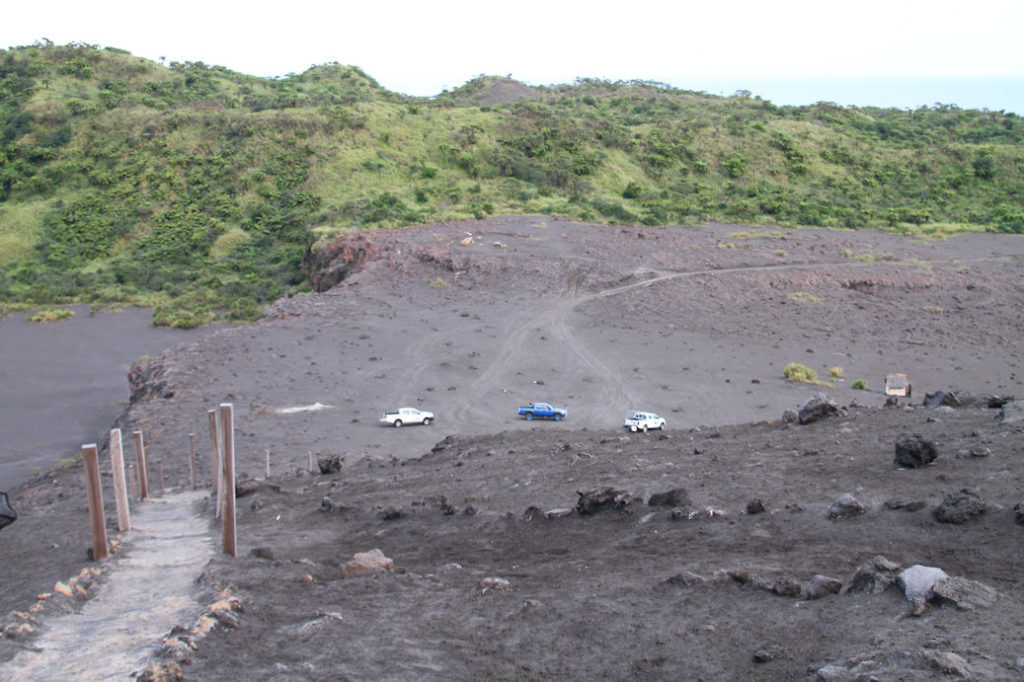
From the path, looking back down to the car park on the mountain. Basic toilet facilities are in the hut on the right.
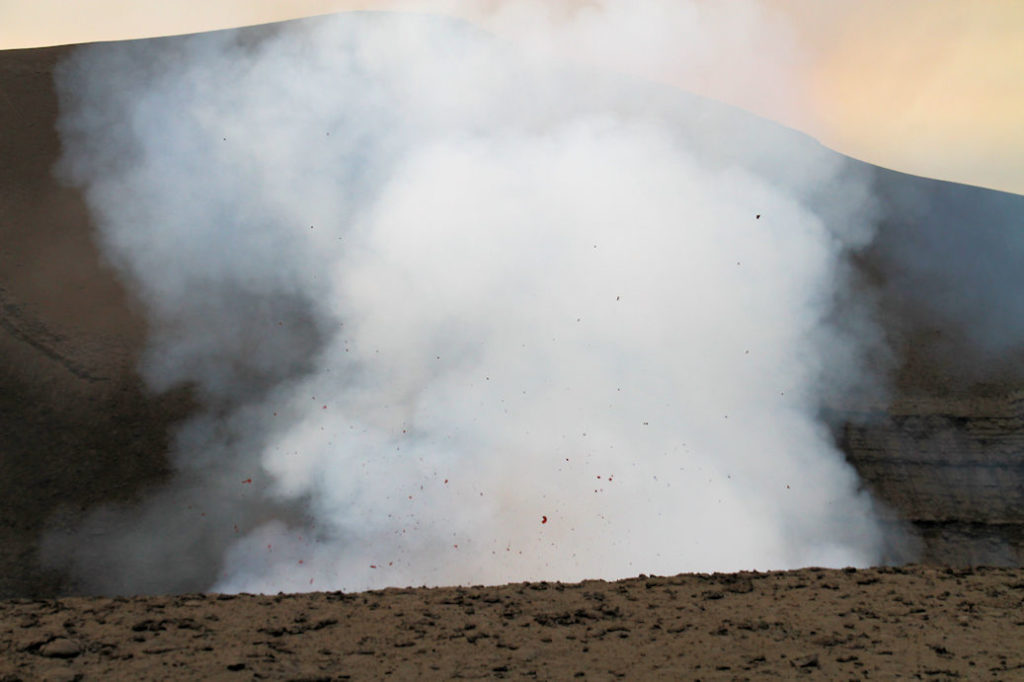
Smoke seen from the holding area. Note the lumps of lava flying in front of the smoke.
Once everyone had reached the holding area an experienced guide went off the see whether it was better to go left or right around the crater. While this happened we were able to observe the smoke and ash being ejected. There were also lava bombs flying into the air, but these looked to be just lumps of rock as it was still full daylight. The noise was much louder here, of course, but due to the wind direction there was none of the expected sulphurous smell and all the ash was being pushed away from us.
The guide returned and beckoned us all to walk to the right. This was quite an easy climb, but there is no defined path – just a row of small volcanic rocks marking the edge of the outer crater. Not a problem in daylight, but not so comfortable when we came back down in the pitch dark! We reached the viewing area and everyone took a vantage point. Those with tripods set them up and waited for the spectacle. Again, there are no fences or handrails here, so it would be very easy to slip over the edge.
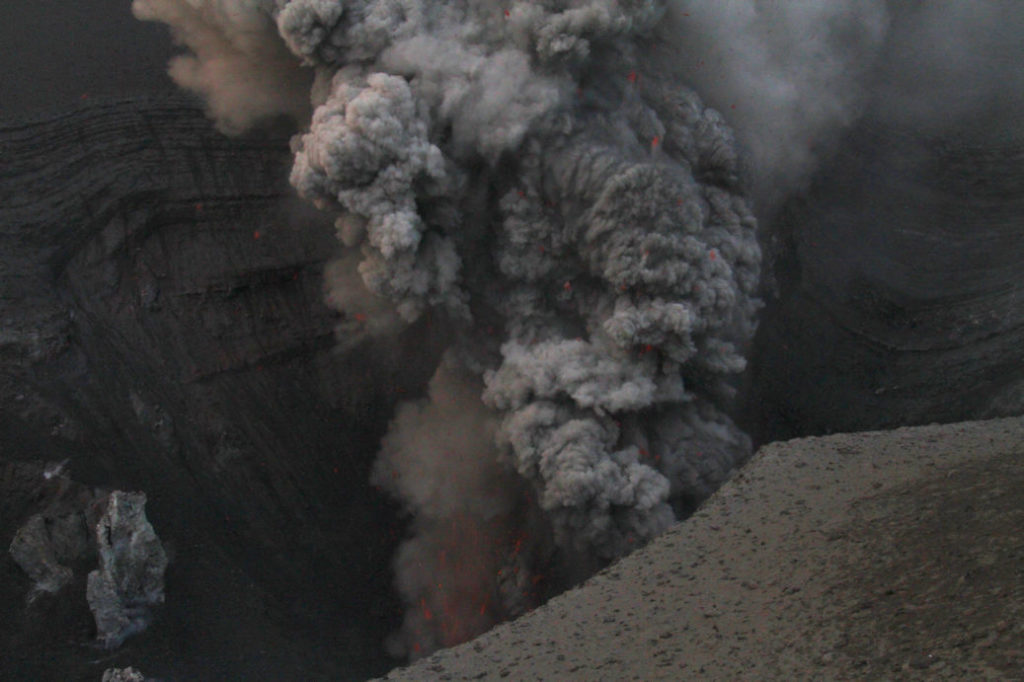
Ash billows from one of the vents. Some molten rock is visible at the base and in front of the cloud.
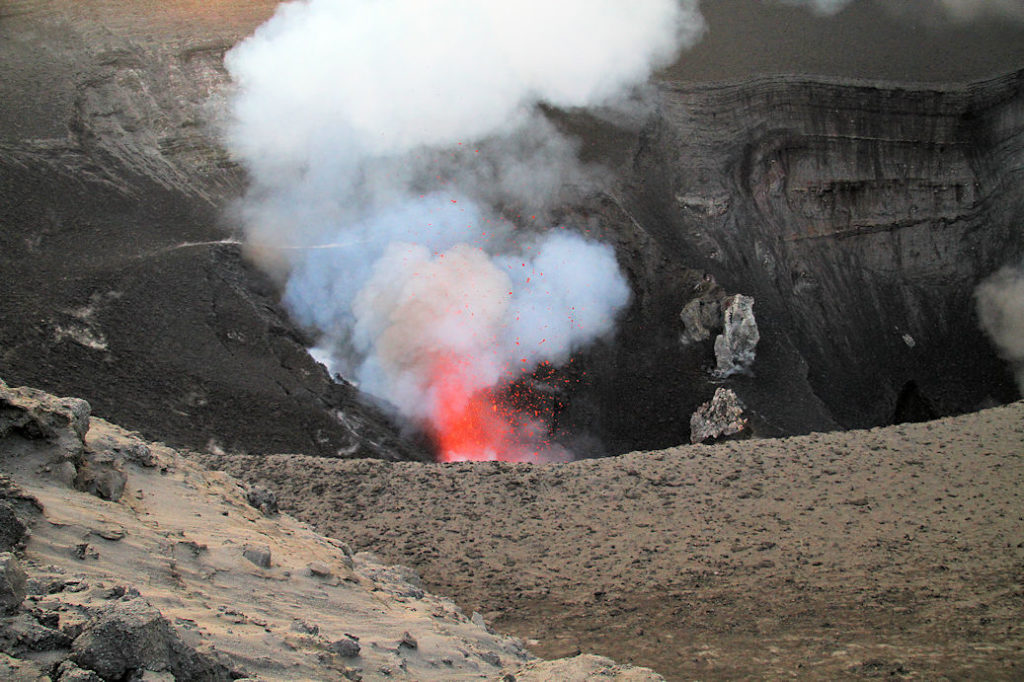
Lava flies into the air from an explosion. The white smoke is caused by water in the crater.
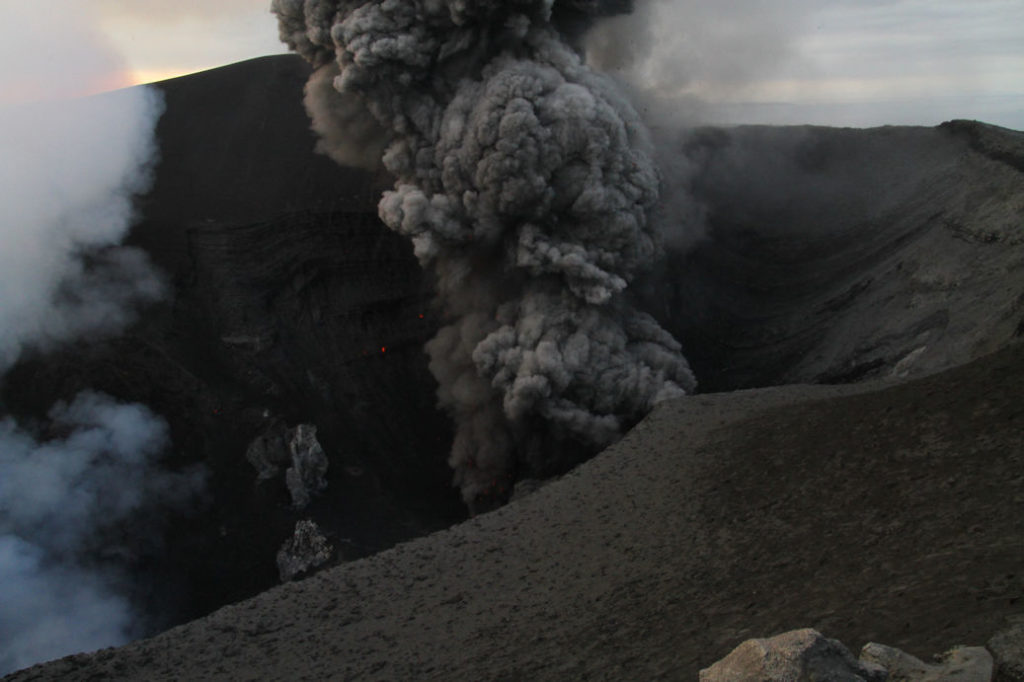
More ash billows upwards. Several lava ‘bombs’ are visible.
To say it is awesome seems so inadequate! The experience of standing on the crater’s edge looking down into the middle of an active volcano is impossible to describe adequately to anyone who hasn’t experienced it! The noise, the fire, the ash clouds, the shaking earth, the heat of large eruptions and the shockwave that comes with them are like nothing else we have experienced. As the sun set spectacularly behind the volcano the visual effect of the eruptions increased, so that by the time it was dark the light show was breathtaking.
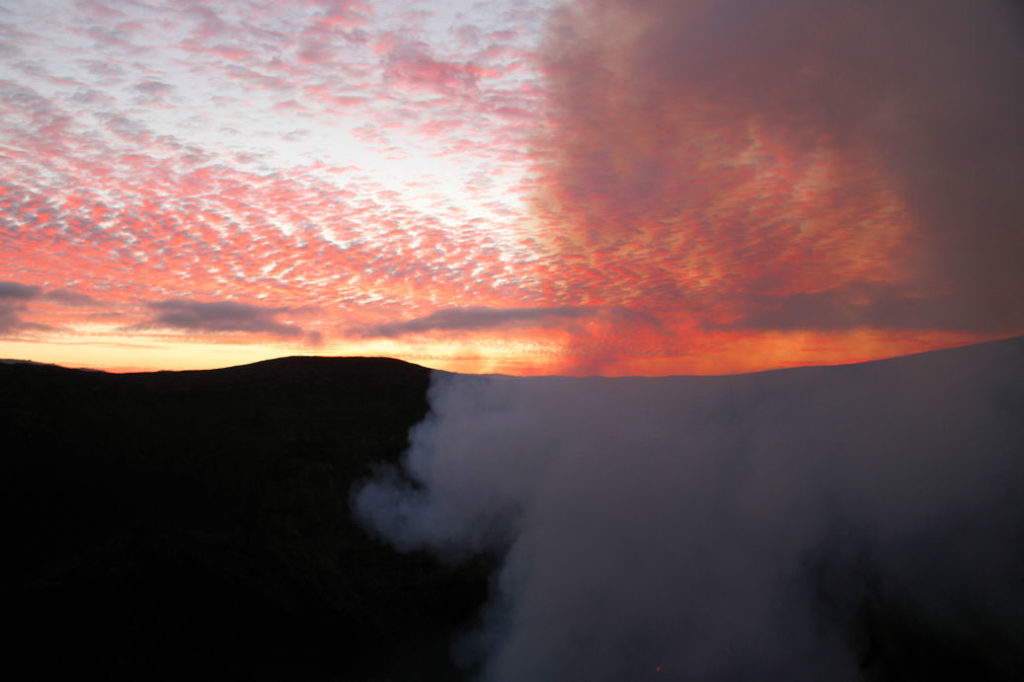
Sunset behind the mountain.
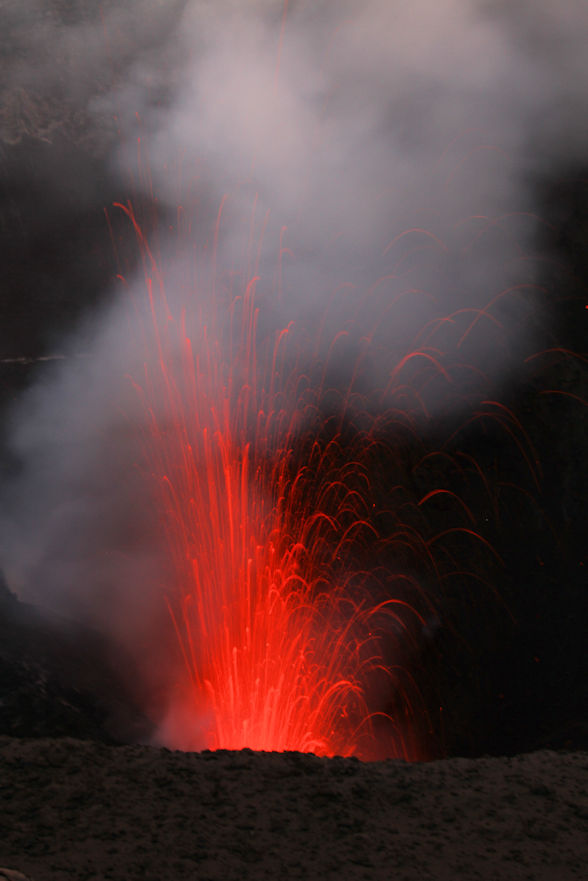
As it got dark the eruptions became more spectacular.
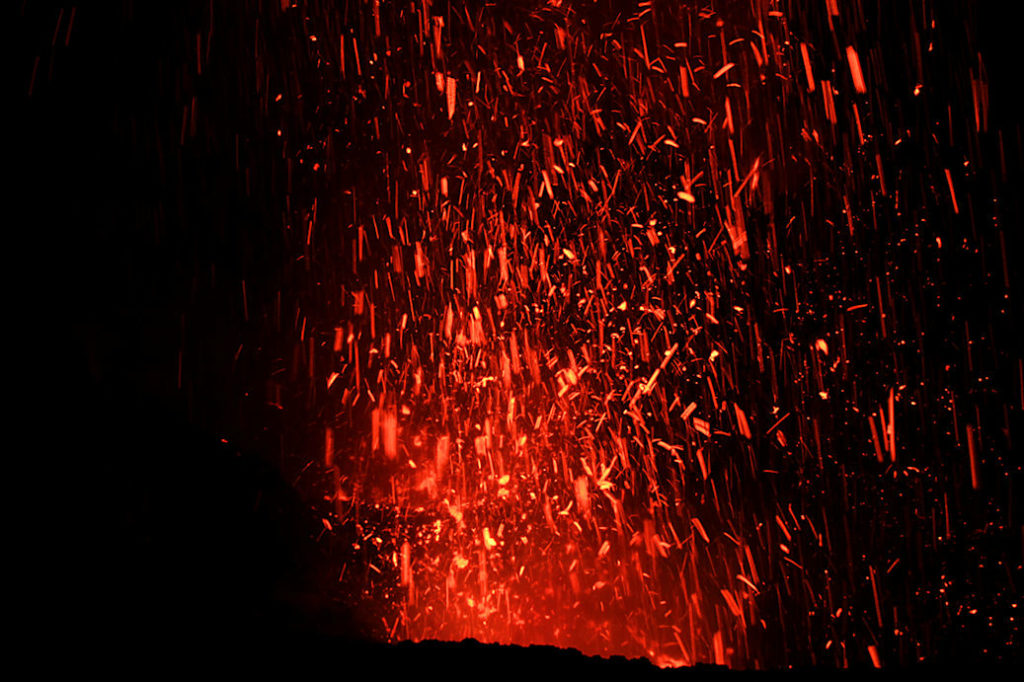
Magma ejected by the explosions fell like rain.
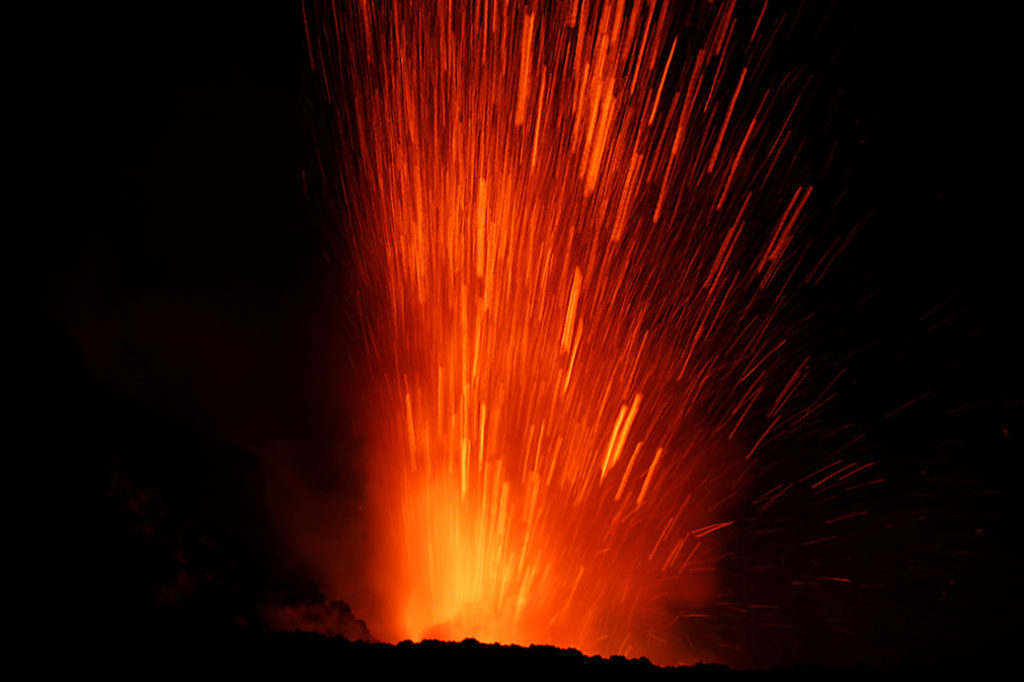
Every eruption made an awesome sight.
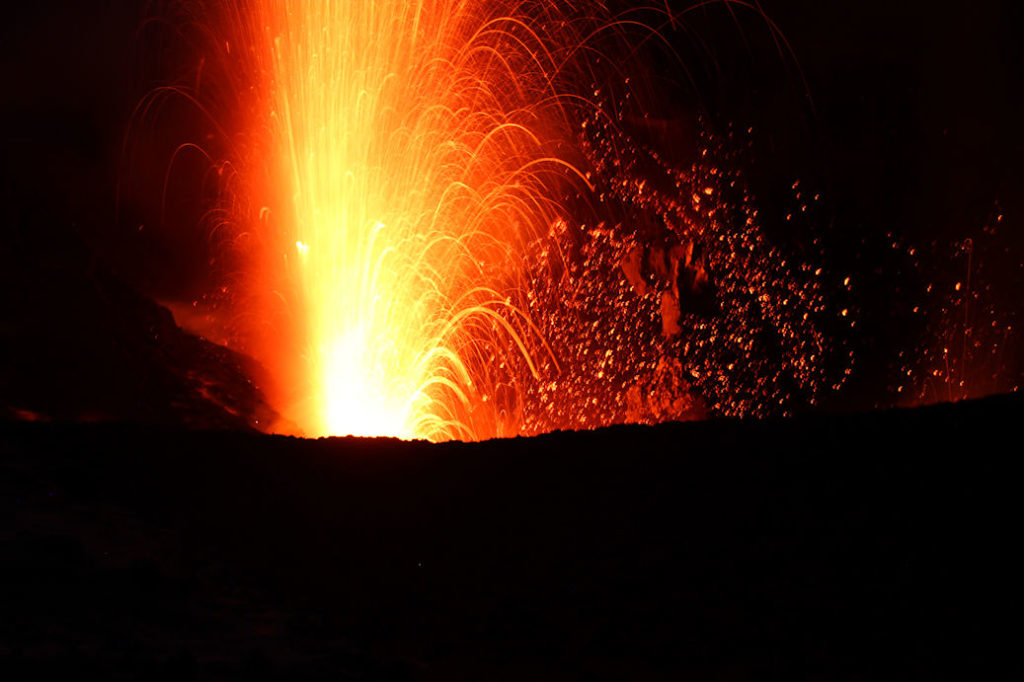
As the lava fell down it glowed on the sides of the inner crater.
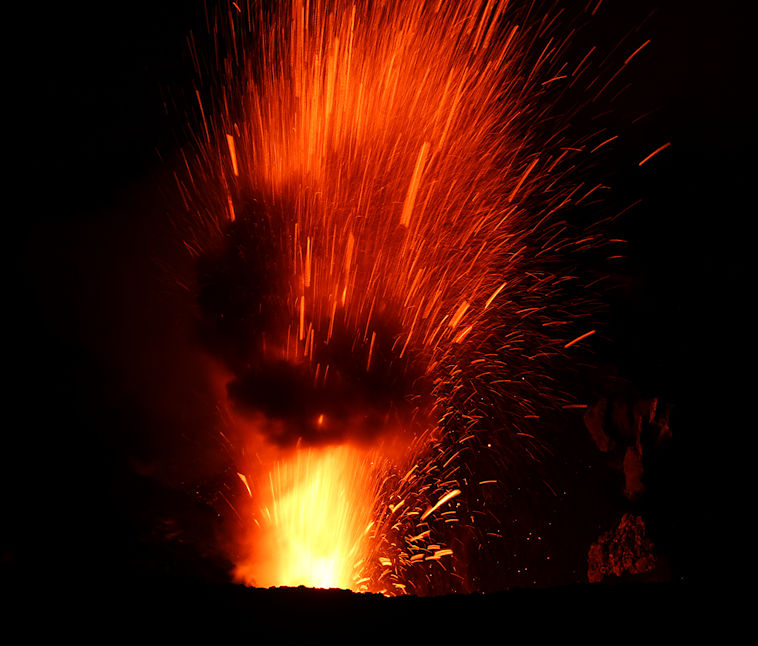
Some of the eruptions came with a fireball and real shockwave that physically hit you.
The sun had set at about 5:25pm and around 6:30pm the guides called for everyone to make their way back down to the car park. By this time it was completely dark and without lights it was impossible to see the path. We were lucky in that one of the guides gave Peter a torch, although this was rather dull. Kerry used the light on her iPhone, which provided a good light. We think it would be a good idea to ensure that you have a light of some sort as you cannot get down safely without one.
It is recommended in many publications that visitors should take a jumper or cardigan with them as it can get cold on the mountain. Peter and Kerry took jumpers but found them unnecessary, as the wind was not particularly cool. One thing you do need, though, is proper shoes. The path is reasonably steep and running shoes or sneakers give you confidence in your footing. At White Grass they told us thongs would be ok, but I think such footwear would not be good to wear on the way down in the dark.
We think another essential item is a tripod for any camera that you have. Movies are satisfactory on a hand held camera, but a tripod is necessary to prevent camera shake showing up in your still pictures. This is especially so when it gets darker as automatic programs keep the shutter open longer to get the correct exposure.
There is a Vanuatu post box on the way up to the crater rim so that tourists can send postcards that are postmarked Mt Yasur. If you want to do that you need to bring the stamped postcards with you as there is nowhere to buy them on the mountain.
Once we came down from the crater the reception area had put out fruit to eat, surprisingly accompanied by mini Tim Tam and Scotch Finger biscuits. After that we got back in the White Grass Landcruiser and sped back to the resort, arriving at about 8:15pm.
Before we left White Grass earlier we had ordered our dinner, so when we got back the resort had it ready after we had a quick shower.
All in all the experience is incredible. It is something we never imagined being able to do, but if we go to Vanuatu again the volcano tour is definitely something we will do. After having experienced it at night,we think that a day trip to the mountain would not have quite the same effect. While the explosions are just as loud in the daylight, the fire erupting from the earth was so much more formidable after the sun had set.
